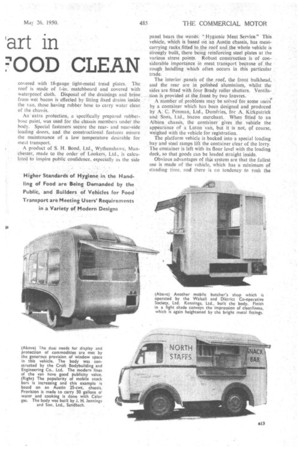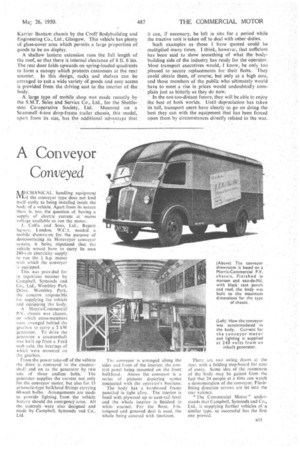The Operator'E 'art in KEEPIN(
Page 46

Page 47

Page 48

Page 49

If you've noticed an error in this article please click here to report it so we can fix it.
FOOD CLEAN By Ashley Taylor, A.I.R.T.E.
HE manner in which food is handled and transported has lately occasioned some disapproving comment. Letters to the Press and complaints at
c nferences have made it clear that many members of ti e public are taking a keen interest in the way that f odstuffs, particularly meat, are treated.
At one conference, in the North, of women's organiza t ons, delegates reported that dirty meat was being d livered to butchers' shops, that many of the vehicles u ed were obviously not intended for the purpose, and t at carcasses were carried on the floor instead of being hung from the roof. A strongly worded resolution was sat forward for the agenda of the national convention, lling upon the Ministry of Food to insist upon more s iitable vehicles and to improve conditions in the handling of food generally.
During and immediately after the war, it was realized t at circumstances beyond the control of the responsible authorities prevented adherence to the old standards, ut this tolerance has now gone and insistent public c implaints can be expected by the negligent. , . Readers of ", The Commercial Motor" will know the
ifficulties which have been faced by those responsible fir food transport, but knowing what is required and a tually obtaining it during the past 10 years have been t o entirely different matters. Even when all the
B12
requisite fittings are obtainable, there must obviously be a time-lag before all the war-time vehicles can be replaced and specially designed machines put on the road in their stead.
The bodybuilding industry knows what is required, and those who have paid visits to the various shows will have seen how much attention has been given to this question. Invariably the executives responsible for food-transport vehicles would welcome the opportunity of having new machines. Except at great cost, however, existing fleets cannot be scrapped . . but there is every reason to believe that in the course of a few years, complaints on this score will be entirely eliminated.
The baconand ham-curing company of Marsh and Baxter, Ltd., has its own bodyworks at Brierley Hill, Staffs, and a particularly interesting insulated meat van based on a Leyland Beaver chassis was recently added to its fleet. With a 15-ft. 6-in, wheelbase, the Beaver easily accommodates an insulated van body 20 ft. long, with a capacity of 875 cubic ft. Employed for transporting frozen pork, meat, bacon and similar commodities, for ships' stores. thevan has an interior height of 6 ft. 3 ins. The panelling is in I8-gauge
sheeting with Onazote 2-in.-thick insulation.
Timber I in. thick is used for the floor and wheel arches, being treated with pitch for waterproofing and covered with 18-gauge light-metal tread plates. The roof is made of matchboard and covered with waterproof cloth. Disposal of the drainings and brine from wet bacon is effected by fitting fixed drains inside the van, these having rubber hose to carry water clear of the chassis.
An extra protection, a specifically prepared rubberbase paint, was used for the chassis members under the body. Special fasteners secure the rearand nearside loading doors, and the constructional features ensure the maintenance of a low temperature desirable for neat transport.
A product of S. H. Bond, Ltd., Wythenshawe, Manehester, made to the order of Lookers, Ltd., is calculated to inspire public confidence, especially as the side panel bears the words: `,` Hygienic Meat Service." This vehicle, which is based On an Austin chassis, has meatcarrying racks fitted to the roof and the whole vehicle is strongly built, there being reinforcing steel plates at the various stress points. Robust construction is of considerable importance in meat transport because of ,the rough handling which often occurs in this particular trade.
The interior .panels of the roof, the front bulkhead, and the rear are in polished aluminium, whilst the sides are fitted with four Brady roller shutters. Ventila tion is provided at the front by two louvres: •
A number of.problems may be solved for some users by a container which has been designed and produced by A. C. Penman, Ltd., Dumfries, for A. Kirkpatrick and Son-s, Ltd., bacon merchant. When fitted to an Albion chassis, the container• gives the vehicle the appearance of a Luton van, but it is not, of course. weighed with the vehicle for registration.
The platform vehicle is backed into a special loading bay and steel ramps lift the container clear of the lorry. The container is left with its floor level with the loading deck, so that goods can be loaded straight inside.
Obvious advantages of this system are that the fullest use is made of the vehicle, which has a minimum of standing time, and there is co tendency to rush the
loading. In consequence, food can be packed with greater care than is sometimes possible when the work has to be
• done in the morning before deliveries commence. With many types of chassis, this container permits a maximum speed of 30 m.p.h.
Turning to the retail side, one of the acornpanying illustrations shows an attractive mobile butcher's shop, a pro duct of Kennings, Ltd., Clay Cross.
This is based on an Austin 25-cwt. chassis, la-gauge aluminium being used extensively for the exterior ad *gauge,.
aluminium in .the, interior', Whilst the floor is of !-41.. tongued-atidgroo*J deal. Aluminium , panels are employed for Covering the roof, whichis fitted With a full-length-Clerestory With l!erspex patiels.. Three strip windows are fitted on each side.
Behind the driver is a partition with a sliding door in the centre, giving access to the interior where a gangway, about 2 ft. wide, runs between the counter and shelves.
A stainless-steel meat rail runs down each side of the van and along the front. On the off side, the interior is fitted with a display counter, having a cupboard underneath, access to which is obtained by means of lightalloy sliding doors. The serving counter, chopping block and cash till are located on the near side, also with a cupboard underneath. Cased in the bulkhead behind the driver is a Calor-gas water heater with supply tank, waste tank and stainless-steel sink.
Before we leave the question of meat transport, I will _mention another clean and workmanlike example of bCidybuilding, a butcher's van which was recently completed in the coachbuilding division of Appleyard of Leeds, Ltd. The vehicle has sliding windows on both sides with a counter under each.
At the front of the body there are cupboards and a chopping block. At the rear there is a door in the centre with a IOW step, and just inside this entrance there are a wash basin and water tank. The whole vehicle is panelled in aluminium, both inside and out. The floor and all clipboard doors are covered with ribbed alutninium sci=that they can easily be washed down.
Although their customers are less critical, many campaints .are heard regarding the state of mobile snackbars. Here, again, outworn machines are being replaced by .rnore up-to-date types. In one, which I inspected at the Jennings works, the body had ample headroom and instead of the customary clerestory roof, there was a Perspex roof light. Access to the interior was obtained either by way of a rear door or by a sliding door in the cab bulkhead: . • Initial equipment for canteen working includes urns, cooking 'stove, Calor-gas cylinders, stainless-steel sinks,. cold-storage bins, water tank and crockery racks. Counters are aluminium-lined and the floor is rubbercovered. Service is effected through a hatch, having a folding counter and a canopy for weather protection. The maker fits a concealed wash basin to vehicles of various types, particularly those used for retail ice-cream distribution. In this case there is running hot and cold water, the hot water being supplied from vacuum tanks.
In mobile shops, customers are sometimes too close to the food which is exposed for sale. This particular difficulty is eliminated in the travelling shop built on the Kariier Bantam chassis by the Croft Bodybuilding and Engineering Co., Ltd., Glasgow.. This vehicle has plenty of glass-cover area which permits a large proportion of goods to be on display.
A shallow lantern exteniion runs the full length of the roof, so that there is internal clearance of 6 ft. 6 ins. The rear door folds upwards on spring-loaded quadrants to form a canopy which protects customers at the rear counter. In this design, racks and shelves can be arranged to suit a wide variety of goods and easy access is provided from the driving scat to the interior of the body.
A large type of mobile shop was made recently by the S.M.T. Sales and Service Co., Ltd., for the Shettleston Co-operative Society, Ltd. Mounted on a Seamme11.6-ton drop-frame trailer chassis, this model, apart from its size, has the additional advantage that
it can, if necessary, be left in situ for a period while the tractive unit is taken off to deal with other duties.
Such examples, as those I have quoted could be multiplied many times. I think, howe.vet, that sufficient has been said to show something of what the bodybuilding side of the industry has ready for the operator. Most transport executives would, I know, be only too pleased to secure replacements for their fleets. They could obtain them, of course, but only at a high cost, and those members of the public who ultimately would have to meet a rise in prices would undoubtedly complain just as bitterly as they do now.
In the not-too-distant future, they will be able to enjoy the best of both worlds. Until depreciation has taken its toll, transport users have clearly to go on doing the best they can with the equipment that has been forced upon them by circumstances directly related to the war.




























































































